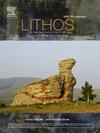Origin and evolution of sub-caldera magmatic systems before and during the caldera-forming eruptions of the Furongshan caldera, SE China
IF 2.9
2区 地球科学
Q2 GEOCHEMISTRY & GEOPHYSICS
引用次数: 0
Abstract
The formation of collapse caldera is commonly associated with large-scale eruptions of silicic magmas, where the magma reservoirs generally undergo long-term accumulation and maturation processes before the caldera-forming eruptions. However, the pre-caldera eruptions have been less documented, since such eruption products are usually concealed by subsequent collapse and filling. The Furongshan caldera in SE China preserves the records of both the pre-caldera and caldera-forming eruption products, providing vital insights into the evolution of the magmatic systems from pre-caldera to caldera-forming eruptions. The pre-caldera volcanic rocks are characterized by small-volume dacite with relatively low SiO2 contents (64–65 wt%), while the caldera-forming volcanic rocks are relatively large-volume crystal-rich tuff with high crystal contents (35–45 vol%) and relatively high SiO2 contents (70–78 wt%). LA-ICP-MS zircon U-Pb dating results show that the age of pre-caldera dacite is 151 ± 1 Ma, and the age of caldera-forming crystal-rich tuff is 148 ± 1–144 ± 1 Ma, which indicates a prolonged evolution of the caldera magmatic systems. Zircon trace elements of the caldera-forming crystal-rich tuff show relatively low Ti contents and Eu/Eu* ratios, consistent with relatively low magma temperatures and high magmatic differentiation. The pre-caldera dacite and the caldera-forming crystal-rich tuff further show different zircon Hf isotopic compositions, with εHf(t) values of −8.7 to −3.5 and −14.2 to −5.5, respectively, indicating higher crustal contributions in the magma of the caldera-forming crystal-rich tuff. We suggest that from the pre-caldera to caldera-forming eruptions at the Furongshan caldera, the contribution of crustal materials in the magma systems increased, and the magmas also gradually evolved, which well recorded the maturation process of the magmatic system of caldera-forming eruption. The eruption of caldera-forming crystal-rich tuff may be related to magma recharge and associated mush rejuvenation within the magma reservoirs.
求助全文
约1分钟内获得全文
求助全文
来源期刊

Lithos
地学-地球化学与地球物理
CiteScore
6.80
自引率
11.40%
发文量
286
审稿时长
3.5 months
期刊介绍:
Lithos publishes original research papers on the petrology, geochemistry and petrogenesis of igneous and metamorphic rocks. Papers on mineralogy/mineral physics related to petrology and petrogenetic problems are also welcomed.
 求助内容:
求助内容: 应助结果提醒方式:
应助结果提醒方式:


